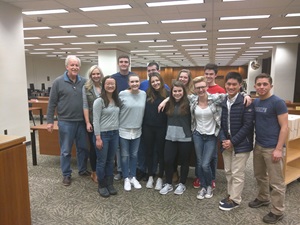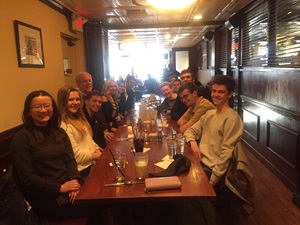Faculty Features
SMU Students Explore Research Avenues at the Library of Congress
Dr. Joseph F. Kobylka, Altshuler Distinguished Teaching Professor, leads a Supreme Court seminar of 12 undergraduates every other spring, which allows these exceptional students to conduct research using the papers of Supreme Court justices in the Library of Congress. Read on to learn more about how the class came to be and experiences from some of his students.
Dr. Kobylka on the origins of the Supreme Court Seminar:
I have been doing research in the Library of Congress since the mid-1990s as a part of the research for my biography of former Justice Blackmun. In addition to uncovering a wealth of previously unknown-to-the-public information, working in the case files of Justices Marshall, Brennan, Blackmun, and White and others was just fun: it gave me a new window into the construction of constitutional law. Over lunch with Jeff Flannery, head of the manuscript division of the Library of Congress, the plan to bring a select seminar to the Library was hatched. The idea of undergraduates doing original research on projects of their own design in the Library was new; Jeff said that it would be unique in his experience, despite dozens of colleges and universities in the Washington, D.C., area. Back in Dallas, I set out to create a way to share the fun with SMU students.

Not just any student would be up to the task of research design and execution involving archived materials. Further, this would be expensive. Enter Dr. David D. Doyle and the Honors Program. Through the generosity of the Richter Foundation, the Honors Program provided funds to help make the idea a reality. We designed a course built around spending spring break working in the Library. We crafted a seminar of 12 students who would spend six days working in the papers of the justices.
The first Supreme Court Seminar hit D.C. in Spring 2011, and we’ve gone back every other year since. After Spring 2019, sixty students will have developed, executed, and written original research informed and buttressed by intense archival work. After graduation they’ve gone on to law school, grad school, economic analysis, the tech world…you name it. What they will always share—and what they carry into the jobs, relationships, and world that they will help to shape—are the skills and insights developed in this extraordinary undergraduate experience and the fun of serious focused, intensive, and original research.
Anna Grace Carey, a third year Political Science and Fashion Media major explains why the seminar was a defining experience of her time on the Hilltop:
The Supreme Court Seminar was the defining experience of my sophomore year and set the tone for what the rest of my time at SMU would look like. This seminar was an amazing experience for several reasons. First, I learned more about the Supreme Court than I ever thought possible. The Court has shaped American life since the 1800s. There are hundreds of significant cases, and in the first part of the semester, Dr. Kobylka touched on a number of these to paint a portrait of the significance of the Court. After building on this foundation, we had the opportunity to design our own research. As a fashion media and political science major, I was interested in the intersection of fashion and intellectual property rights law. My research focused on the Supreme Court’s interpretation of copyright to better understand how they might approach Star v. Varsity, a fashion copyright case that the Court heard earlier that term.
I was able to take what I had learned about copyright and the Court and apply it to research on Star v. Varsity with SMU Professors Jared Schroeder and Camille Kraeplin the following summer. That research analyzed the Court’s decision, how the fashion industry functions, and proposes a new approach to fashion copyright that the Court could adopt in the future. The resulting paper ("Give Me a C") will be published in Volume 26 of the UCLA Entertainment Law Review.
The simplest way I can describe the Supreme Court Seminar is to say it's really cool. The material is really cool. Designing your own research as an undergraduate is really cool. Traveling to Washington, D.C. to dig through the archives in the Library of Congress is really cool. In many ways, this course taught me what it meant to enjoy learning and I will always be grateful for that.
Alex McNamara, a third year Philosophy and Political Science major describes the path his research led him along during the seminar:

The biggest challenge of the Supreme Court Seminar is packing the right attire. No, really. While the course entails reading and then briefing roughly 100 opinions, at least that many hours of independent research, and 30-page paper where you find yourself trying to trim words rather than add them, none of that is insurmountable. I was prepared for all of that by careful study of the Court reinforced by great lectures, various check-ups before the trip about the progress of my research paper, and some friendly warnings from course alums about what to expect. I was not prepared for, in my patently Texas attire of blue jeans and a windbreaker, 15 degrees Fahrenheit after wind shear.
The Supreme Court consists of nine intellectual powerhouses debating age-old and novel questions alike. While the tautological “reasonable minds can disagree” certainly holds true for the highest Court’s majority opinions, that explanation fails to satisfy when a nation’s rights and liberties are at stake. I therefore became increasingly interested in jurisprudence: the study of how judges make the decisions that they do. In particular, I became fascinated with Justice Black’s Originalism, which is a forerunner of arguably over half of today’s Court’s jurisprudence. In my paper I argued that Justice Black’s selective and political use of the doctrine better deserved the title of “Instrumentalism,” and I was fortunate enough to win a national research award for my work.
I’m not going to claim that the class wasn’t challenging; it was certainly the most difficult class of my time here and there are whispers from law students who took the course years ago that it was even harder than their first year classes. But as my classmate Anna Grace said, this stuff is really, really cool. And when it’s cool you’ll forget that it’s “work” at all. Just don’t forget to pack an extra coat and some gloves.